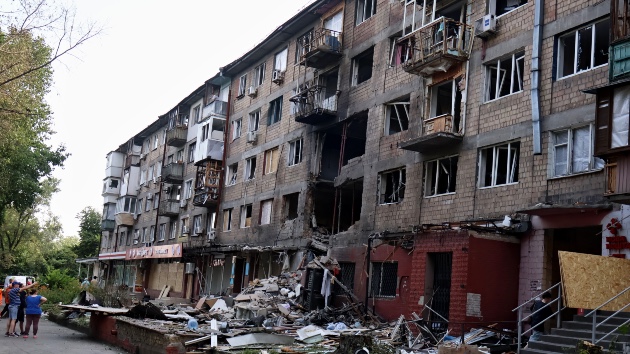
(LONDON) -- Russia launched its largest drone attack of the war on Ukraine overnight into Wednesday, according to Ukrainian President Volodymyr Zelenskyy, with 741 aerial attack vehicles used in the bombardment.
Ukraine's air force said in a post to Telegram that Russia launched 728 drones -- a mix of attack drones and decoys -- and 13 missiles into the country overnight, with the northwestern Volyn region and its city of Lutsk the main targets.
The air force said 711 of the drones were shot down or otherwise neutralized, with seven missiles also intercepted. Impacts were recorded in at least four locations, the air force said.
Zelenskyy said the "massive" attack represented "the highest number of aerial targets in a single day." The president framed the assault as another signal from Moscow that President Vladimir Putin is not invested in U.S.-led efforts to end the war, which began with Russia's full-scale invasion of its neighbor in February 2022.
Damage was reported in the Dnipro, Zhytomyr, Kyiv, Kirovohrad, Mykolaiv, Sumy, Kharkiv, Khmelnytskyi, Cherkasy and Chernihiv regions, Zelenskyy said.
"This is a telling attack," Zelenskyy continued. "It comes precisely at a time when so many efforts have been made to achieve peace, to establish a ceasefire, and yet only Russia continues to rebuff them all."
"This is yet another proof of the need for sanctions -- biting sanctions against oil, which has been fueling Moscow's war machine with money for over three years of the war," he wrote. "Secondary sanctions on those who buy this oil and thereby sponsor killings."
"Our partners know how to apply pressure in a way that will force Russia to think about ending the war, not launching new strikes," Zelenskyy said. "Everyone who wants peace must act."
In Poland -- which borders Ukraine to its west -- the Armed Forces Operational Command said in a post to X that the Russian strikes prompted Polish and allied aircraft to be scrambled.
"Duty fighter pairs have been scrambled and ground-based air defense and radar reconnaissance systems have reached the highest state of readiness," the command wrote in a post to X.
Two hours later, the command issued a new statement noting that the forces had been stood down "due to the reduced threat of Russian missile strikes."
Russia's massed drone and missile attack targeted "the infrastructure of military airfields," the Russian Defense Ministry said in a post to Telegram, claiming that "all designated targets were hit."
Ukraine continued its own cross-border attacks into Russia overnight, with the Defense Ministry in Moscow saying in a post to Telegram that its forces downed 86 Ukrainian drones overnight. Four drones were intercepted over the Moscow region, the ministry said.
Artem Korenyako, the press secretary for Russia's Federal Air Transport Agency, said in a post to Telegram that flight restrictions were temporarily put in place at Sheremetyevo Airport in Moscow.
The latest Russian barrage comes amid escalating aerial cross-border attacks by Moscow. June saw a new monthly record for the number of long-range drones and missiles launched into Ukraine -- 5,438 drones and 239 missiles -- according to figures published by the Ukrainian air force.
Despite the trend toward larger and more frequent strikes, President Donald Trump's administration last week confirmed it had frozen the shipment of some air defense and precision guided weapons that were on track to be sent to Ukraine, citing concerns about U.S. stockpiles.
Among the munitions held up were interceptor missiles for Ukraine's Patriot surface-to-air systems, which have proven invaluable in Kyiv's defense against Russian drones and -- in particular -- ballistic missiles.
On Tuesday, Trump told reporters he did not know who ordered the freeze. "I don't know, why don't you tell me?" the president responded when asked who was responsible.
One U.S. official told ABC News that officials are analyzing which weapons should be sent to Ukraine by using a stoplight chart -- designating specific systems with red, yellow or green status. Red status suggests that U.S. supply of a particular munition is dangerously low, the official said.
Zelenskyy said Tuesday he had instructed his defense officials to "intensify all contacts with the American side" on the issue of continued military aid.
"This primarily concerns air defense, as well as all other elements of supplies from America," the president said in a post to social media. "This is critical aid, on which the saving of lives of our people and the defense of Ukrainian cities and villages depend," he said.
"I expect results from these contacts in the near future, and in particular, we are preparing meeting formats for our teams -- both military and political -- this week," Zelenskyy said.
ABC News' Anne Flaherty, Luis Martinez, Hannah Demissie, Will Gretsky and Joe Simonetti contributed to this report.
Copyright © 2025, ABC Audio. All rights reserved.

